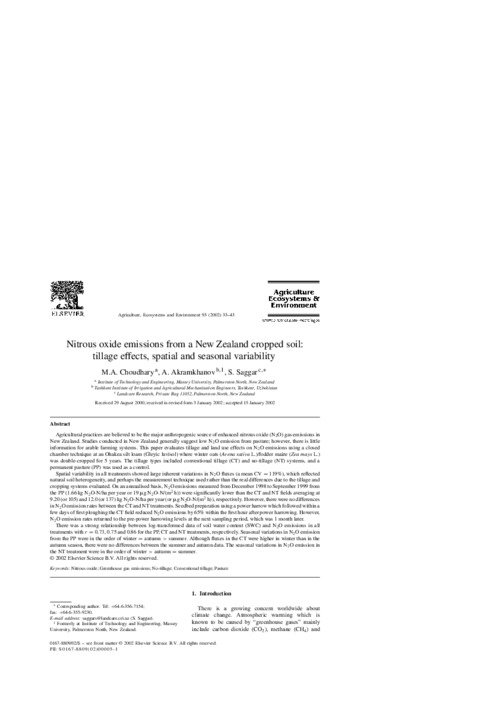Nitrous oxide emissions from a New Zealand cropped soil: tillage effects, spatial and seasonal variability
Abstract
Agricultural practices are believed to be the major anthropogenic source of enhanced nitrous oxide (N2O) gas emissions in
New Zealand. Studies conducted in New Zealand generally suggest low N2O emission from pasture; however, there is little
information for arable farming systems. This paper evaluates tillage and land use effects on N2O emissions using a closed
chamber technique at an Ohakea silt loam (Gleyic luvisol) where winter oats (Avena sativa L.)/fodder maize (Zea mays L.)
was double-cropped for 5 years. The tillage types included conventional tillage (CT) and no-tillage (NT) systems, and a
permanent pasture (PP) was used as a control.
Spatial variability in all treatments showed large inherent variations in N2O fluxes (a mean CV = 119%), which reflected
natural soil heterogeneity, and perhaps the measurement technique used rather than the real differences due to the tillage and
cropping systems evaluated. On an annualised basis, N2O emissions measured from December 1998 to September 1999 from
the PP (1.66 kg N2O-N/ha per year or 19 g N2O-N/(m2 h)) were significantly lower than the CT and NT fields averaging at
9.20 (or 105) and 12.0 (or 137) kg N2O-N/ha per year (or gN2O-N/(m2 h)), respectively. However, there were no differences
in N2O emission rates between the CT and NT treatments. Seedbed preparation using a power harrow which followed within a
few days of first ploughing the CT field reduced N2O emissions by 65% within the first hour after power harrowing. However,
N2O emission rates returned to the pre-power harrowing levels at the next sampling period, which was 1 month later.
There was a strong relationship between log-transformed data of soil water content (SWC) and N2O emissions in all
treatments with r = 0.73, 0.75 and 0.86 for the PP, CT and NT treatments, respectively. Seasonal variations in N2O emission
from the PP were in the order of winter = autumn > summer. Although fluxes in the CT were higher in winter than in the
autumn season, there were no differences between the summer and autumn data. The seasonal variations in N2O emission in
the NT treatment were in the order of winter > autumn = summer.
© 2002 Elsevier Science B.V. All rights reserved

